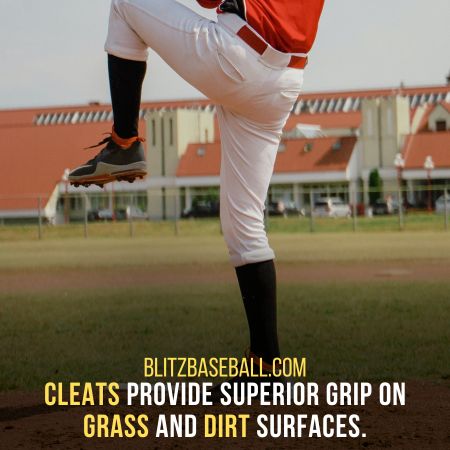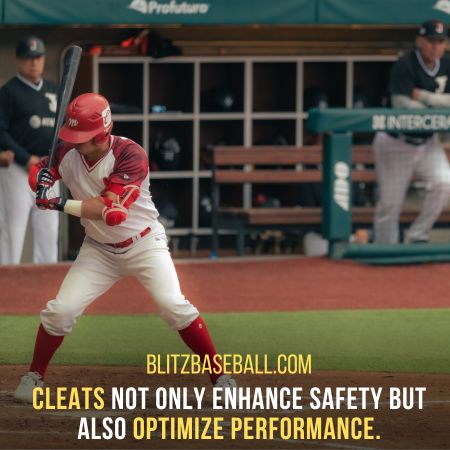Cleats, an integral component of a baseball player’s attire, serve a multifaceted purpose that extends beyond mere footwear.
In the world of sports, especially baseball, where agility, speed, and precision are paramount, the choice of cleats is a critical decision that directly influences a player’s performance, safety, and overall experience on the field.
In this comprehensive exploration, we’ll delve into the reasons why do baseball players wear cleats, dissecting their design, impact on gameplay, and the evolution of technology that has transformed these seemingly ordinary shoes into essential tools of the trade.
Key Points:
- Cleats provide superior grip on grass and dirt surfaces, enabling quick movements, sharp turns, and secure fielding that regular sneakers cannot offer.
- Cleats contribute to player safety by reducing slips and falls, while ankle support features help prevent sprains and twists during dynamic gameplay.
- Cleats not only enhance safety but also optimize performance, allowing players to execute plays with confidence and agility, making them an essential tool on the baseball field.
The Science of Traction: A Foundation of Performance
- Enhanced Grip and Traction: The primary purpose of cleats in baseball is to provide superior grip and traction on the playing surface. Baseball fields often consist of grass, dirt, and sometimes wet or slippery conditions. Cleats, with their specialized stud patterns and materials, dig into the ground, preventing slippage during quick sprints, sudden stops, and agile maneuvers.
- Minimized Slippage: The ability to grip the ground reduces the risk of slippage, enabling players to make sharp turns, steal bases, and field ground balls with confidence. This increased control over movement is particularly crucial for base runners looking to gain an edge and outfielders tracking down deep hits.
Anatomy of Cleats: Designing for Performance
- Stud Configurations: Cleats feature various stud configurations, including metal, plastic, or rubber studs arranged strategically on the sole. These studs vary in length and placement to optimize traction while minimizing discomfort and pressure points.
- Position-Specific Designs: Baseball cleats are designed with position-specific considerations. Infielders require quick lateral movements and frequent changes in direction, often favoring cleats with shorter studs. Outfielders, on the other hand, benefit from longer studs for stability and traction on various surfaces.

Safety First: Injury Prevention on the Field
- Ankle Support and Stability: Cleats not only enhance performance but also contribute to player safety. Many modern cleats feature ankle support technology that helps stabilize the foot and ankle, reducing the risk of sprains and other lower extremity injuries during dynamic movements.
- Impact Absorption: Cleats incorporate cushioning materials to absorb shock and impact forces, offering protection against the jarring collisions and sudden stops that are common in baseball.
Evolution and Technological Advancements: From Tradition to Innovation
- Historical Progression: The evolution of cleats in baseball mirrors the sport’s growth and changing demands. Early designs were often rudimentary, focusing on basic traction. Over time, innovations led to the incorporation of lightweight materials, improved stud patterns, and more ergonomic fits.
- Modern Materials and Performance: Cutting-edge materials like synthetic leather, breathable mesh, and lightweight plastics are now integral to cleat construction. These advancements enhance comfort, durability, and overall performance, allowing players to focus on their game without footwear-related distractions.
Personalization and Preference: The Perfect Fit
- Customization and Aesthetic Appeal: Many players opt for personalized cleats that reflect their style, team colors, and personal preferences. Custom designs and colors not only enhance individuality but also foster a sense of identity and camaraderie among teammates.
- Optimal Fit for Maximum Performance: A well-fitting pair of cleats minimizes discomfort and blisters, allowing players to concentrate fully on their game. Cleats that are too loose can result in unstable footing, while overly tight cleats can lead to discomfort and injury.
Metal Cleats in Baseball
Metal cleats in baseball offer unparalleled traction and stability on the field.
These specialized cleats feature metal spikes that dig into the ground, providing a secure grip on grass and dirt surfaces.
Baseball players opt for metal cleats to enhance their speed, agility, and control during quick movements, such as stealing bases and making sharp turns.
The strategic placement of metal spikes ensures players can generate maximum power while minimizing slippage, making them a favored choice for competitive play and professional leagues.

Baseball Cleats vs. Other Sports Cleats
While cleats serve as a common denominator across various sports, the nuances of design and functionality tailored to each sport’s unique demands set them apart.
Baseball cleats, in particular, exhibit distinct features that differentiate them from cleats used in football and soccer.
Baseball Cleats: Precision in Performance
Baseball cleats are specifically engineered to cater to the intricate demands of the game.
The design focuses on enhancing traction for sudden bursts of speed, quick directional changes, and precise maneuvers on grass and dirt surfaces.
These cleats typically have a low-cut profile, providing the necessary ankle flexibility for movements like stealing bases and fielding ground balls.
The stud configurations of baseball cleats are designed to strike a balance between grip and minimizing discomfort during prolonged periods of play.
Football Cleats: Tackling the Turf
Football cleats, on the other hand, prioritize stability and grip on turf or synthetic surfaces.
They often feature larger studs, sometimes with a bladed or conical shape, to optimize traction on artificial grass.
The high-top design of football cleats provides enhanced ankle support and protection, crucial for withstanding the high-impact collisions and abrupt changes in direction characteristic of football gameplay.
Soccer Cleats: Agility and Ball Control
Soccer cleats emphasize agility, ball control, and maneuverability on the field.
Lightweight and low-profile, they feature numerous small, often conical, studs that offer optimal balance and agility on grass surfaces.
The snug fit of soccer cleats ensures minimal interference with ball-handling skills, while their reduced stud configuration helps prevent injuries during slide tackles and close-quarters play.
Crossover Considerations: Versatility and Preference
While each sport’s cleats are tailored to its specific demands, athletes may opt for crossover use based on personal preference.
Baseball players, for instance, might find football cleats beneficial on wet or muddy fields due to their sturdy traction.
Conversely, soccer cleats’ versatility and agility may appeal to athletes engaging in baseball or softball recreational games.
In essence, the distinction between baseball cleats and those of football and soccer lies in the finely tuned balance between traction, support, agility, and comfort, each catering to the unique demands of their respective sports.
As athletes lace up their cleats, they step onto the field equipped with the tools best suited to amplify their performance, demonstrating the harmonious fusion of technology and athleticism.

Frequently Asked Questions
Why do baseball players wear cleats instead of regular sneakers?
Baseball players wear cleats for enhanced traction and stability on the field. Cleats’ specialized design, with stud patterns and materials, prevents slippage on grass and dirt surfaces. This traction is vital for quick sprints, sharp turns, and secure fielding, which are integral to the game. Regular sneakers lack the grip needed for these dynamic movements, making cleats the preferred choice for optimal performance.
How do cleats contribute to player safety on the baseball field?
Cleats not only boost performance but also play a crucial role in player safety. The improved grip prevents slips and falls during fast-paced actions, reducing the risk of injury. Many cleats incorporate ankle support features that stabilize the foot and ankle, decreasing the likelihood of sprains and twists. Additionally, cleats’ impact-absorbing properties cushion jarring collisions and sudden stops, providing an extra layer of protection during intense gameplay.
Conclusion
Cleats have seamlessly woven themselves into the fabric of baseball, transcending their utilitarian role to become integral to a player’s performance, safety, and sense of identity.
From the science of traction to the intricacies of design, the evolution of technology has elevated cleats from rudimentary footwear to precision-engineered tools that optimize gameplay.
As baseball players lace up their cleats and step onto the field, they harness the combined power of grip, stability, and innovation, epitomizing the marriage of tradition and progress that defines America’s favorite pastime.
